Linking spermatid ribonucleic acid (RNA) binding protein and retrogene diversity to reproductive success
- PMID: 23938467
- PMCID: PMC3820935
- DOI: 10.1074/mcp.M113.030585
Linking spermatid ribonucleic acid (RNA) binding protein and retrogene diversity to reproductive success
Abstract
Spermiogenesis is a postmeiotic process that drives development of round spermatids into fully elongated spermatozoa. Spermatid elongation is largely controlled post-transcriptionally after global silencing of mRNA synthesis from the haploid genome. Here, rats that differentially express EGFP from a lentiviral transgene during early and late steps of spermiogenesis were used to flow sort fractions of round and elongating spermatids. Mass-spectral analysis of 2D gel protein spots enriched >3-fold in each fraction revealed a heterogeneous RNA binding proteome (hnRNPA2/b1, hnRNPA3, hnRPDL, hnRNPK, hnRNPL, hnRNPM, PABPC1, PABPC4, PCBP1, PCBP3, PTBP2, PSIP1, RGSL1, RUVBL2, SARNP2, TDRD6, TDRD7) abundantly expressed in round spermatids prior to their elongation. Notably, each protein within this ontology cluster regulates alternative splicing, sub-cellular transport, degradation and/or translational repression of mRNAs. In contrast, elongating spermatid fractions were enriched with glycolytic enzymes, redox enzymes and protein synthesis factors. Retrogene-encoded proteins were over-represented among the most abundant elongating spermatid factors identified. Consistent with these biochemical activities, plus corresponding histological profiles, the identified RNA processing factors are predicted to collectively drive post-transcriptional expression of an alternative exome that fuels finishing steps of sperm maturation and fitness.
Figures
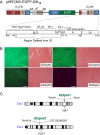
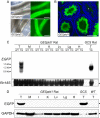

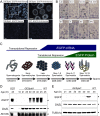
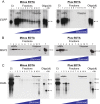
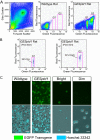
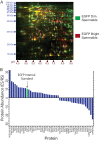
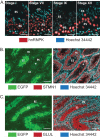
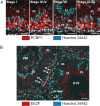
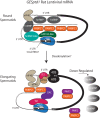
Similar articles
-
AKAP3 synthesis is mediated by RNA binding proteins and PKA signaling during mouse spermiogenesis.Biol Reprod. 2014 Jun;90(6):119. doi: 10.1095/biolreprod.113.116111. Epub 2014 Mar 19. Biol Reprod. 2014. PMID: 24648398
-
Position-dependent interactions of Y-box protein 2 (YBX2) with mRNA enable mRNA storage in round spermatids by repressing mRNA translation and blocking translation-dependent mRNA decay.Mol Reprod Dev. 2016 Mar;83(3):190-207. doi: 10.1002/mrd.22616. Epub 2016 Mar 7. Mol Reprod Dev. 2016. PMID: 26773323 Review.
-
Mouse EWSR1 is crucial for spermatid post-meiotic transcription and spermiogenesis.Development. 2021 Jun 1;148(11):dev199414. doi: 10.1242/dev.199414. Epub 2021 Jun 8. Development. 2021. PMID: 34100066 Free PMC article.
-
Poly (A) binding protein is bound to both stored and polysomal mRNAs in the mammalian testis.Mol Reprod Dev. 1995 Mar;40(3):273-85. doi: 10.1002/mrd.1080400303. Mol Reprod Dev. 1995. PMID: 7772337
-
Haploid spermatids exhibit translationally repressed mRNAs.Anat Embryol (Berl). 2001 May;203(5):323-34. doi: 10.1007/s004290100176. Anat Embryol (Berl). 2001. PMID: 11411307 Review.
Cited by
-
Causal and Candidate Gene Variants in a Large Cohort of Women With Primary Ovarian Insufficiency.J Clin Endocrinol Metab. 2022 Feb 17;107(3):685-714. doi: 10.1210/clinem/dgab775. J Clin Endocrinol Metab. 2022. PMID: 34718612 Free PMC article.
-
Deletion of Hnrnpk Gene Causes Infertility in Male Mice by Disrupting Spermatogenesis.Cells. 2022 Apr 9;11(8):1277. doi: 10.3390/cells11081277. Cells. 2022. PMID: 35455958 Free PMC article.
-
Cancer the'RBP'eutics-RNA-binding proteins as therapeutic targets for cancer.Pharmacol Ther. 2019 Nov;203:107390. doi: 10.1016/j.pharmthera.2019.07.001. Epub 2019 Jul 11. Pharmacol Ther. 2019. PMID: 31302171 Free PMC article. Review.
-
A-single spermatogonia heterogeneity and cell cycles synchronize with rat seminiferous epithelium stages VIII-IX.Biol Reprod. 2014 Feb 13;90(2):32. doi: 10.1095/biolreprod.113.113555. Print 2014 Feb. Biol Reprod. 2014. PMID: 24389876 Free PMC article.
-
RAPID COMMUNICATION: Multi-breed validation study unraveled genomic regions associated with puberty traits segregating across tropically adapted breeds1.J Anim Sci. 2019 Jul 2;97(7):3027-3033. doi: 10.1093/jas/skz121. J Anim Sci. 2019. PMID: 30997484 Free PMC article.
References
-
- Zhu H., Shyh-Chang N., Segre A. V., Shinoda G., Shah S. P., Einhorn W. S., Takeuchi A., Engreitz J. M., Hagan J. P., Kharas M. G., Urbach A., Thornton J. E., Triboulet R., Gregory R. I., Altshuler D., Daley G. Q. (2011) The Lin28/let-7 axis regulates glucose metabolism. Cell 147, 81–94 - PMC - PubMed
Publication types
MeSH terms
Substances
Grants and funding
LinkOut - more resources
Full Text Sources
Other Literature Sources
Miscellaneous

